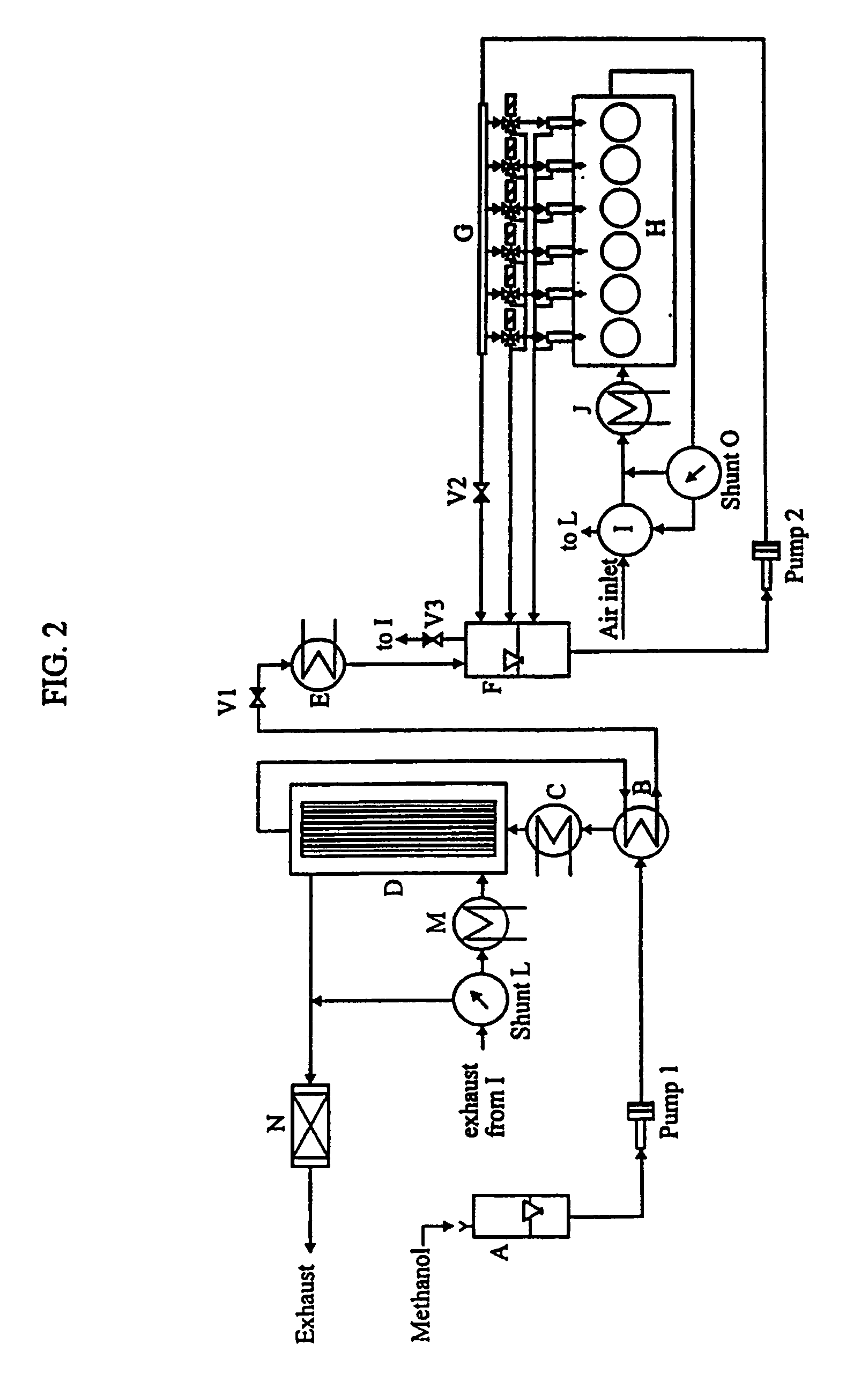Continuous dehydration of alcohol to ether and water used as fuel for diesel engines
a technology of diesel engine and alcohol, which is applied in the direction of domestic stoves or ranges, heating types, applications, etc., can solve the problems that the majority of the energy contained in the exhaust gas is normally wasted as heat loss, and achieves the effects of reducing emissions, ensuring energy supply, and increasing overall fuel efficiency
- Summary
- Abstract
- Description
- Claims
- Application Information
AI Technical Summary
Benefits of technology
Problems solved by technology
Method used
Image
Examples
example 1
Neat DME as Reference Fuel (Fuel No. 1)
[0046]The engine was started on neat DME. The engine load was adjusted to 1 kW and stabilised. The engine was operated for approximately 5 minutes—until stable exhaust temperature was seen. All measurable parameters as described were measured and noted every minute on a log sheet. Then the inlet temperature of the intake air was heated to 125° C. After stabilisation a new set of measurements was executed. Inlet air heating was cut-off and the engine was stopped.
[0047]The results of these two data sets are shown in Table 3. All measured components (NOx, HC, CO, O2, CO2) in the exhaust gas are given as volume amounts. Fuel consumption (FC) are given as actual consumption in g / hour and as calculated values as MJ / hour based on energy content specified as lower heating value (LHV) of the specific fuel tested given in Table 1.
[0048]
TABLE 3Inlet AirExhausttemper-temper-atureatureFCFCNOxHCCOO2CO2° C.° C.gram / hMJ / hPPMPPM%%% 1020678822.741191630.07316.13...
example 2
Diesel as Reference Fuel (Fuel No. 2)
[0050]In order to compare fuel consumption and emissions diesel fuel was applied as fuel. The Swedish low sulphur fuel type MK-1 was selected for this purpose. The engine was operated without preheated air only. The results are given in Table 4.
[0051]
TABLE 4Inlet AirExhausttemper-temper-atureatureFCFCNOxHCCOO2CO2° C.° C.gram / hMJ / hPPMPPM%%%10204538.822.63388310.06315.73.8
Discussion of Results
[0052]It appears that the efficiency is almost the same as obtained with neat DME fuel. Emissions of NOx were more than 3 times higher with diesel fuel compared to the DME operation.
example 3
Diesel Fuel Composition (Fuel No. 3)
[0053]DME / methanol / water composition=60 / 15 / 25 wt / wt %.
[0054]According to the chemical equilibrium calculations shown in FIG. 1 concentrations close to 60% DME, 15% methanol and 25% water all by mass are obtained at 300° C. dehydration temperature and 20 bar. A fuel mixture having this composition was prepared and tested according to the test procedure described above. The diesel engine was started on neat DME. Load on the engine was set to 40% by means of the electrical heater (1 Kw). Air inlet was heated to 124° C. and stabilised. The 3-way valve was switched from neat DME to fuel No. 3. It was observed that the engine kept running on the specified fuel composition. The fuel consumption and emissions were measured. The air inlet temperature were reduced to 105° C. The engine operation was slightly uneven. Fuel consumption was calculated and emissions measured. Further reduction of air inlet temperature to 80° C. resulted in a definitely more unev...
PUM
| Property | Measurement | Unit |
|---|---|---|
| pressure | aaaaa | aaaaa |
| pressure | aaaaa | aaaaa |
| temperature | aaaaa | aaaaa |
Abstract
Description
Claims
Application Information
 Login to View More
Login to View More - R&D
- Intellectual Property
- Life Sciences
- Materials
- Tech Scout
- Unparalleled Data Quality
- Higher Quality Content
- 60% Fewer Hallucinations
Browse by: Latest US Patents, China's latest patents, Technical Efficacy Thesaurus, Application Domain, Technology Topic, Popular Technical Reports.
© 2025 PatSnap. All rights reserved.Legal|Privacy policy|Modern Slavery Act Transparency Statement|Sitemap|About US| Contact US: help@patsnap.com



